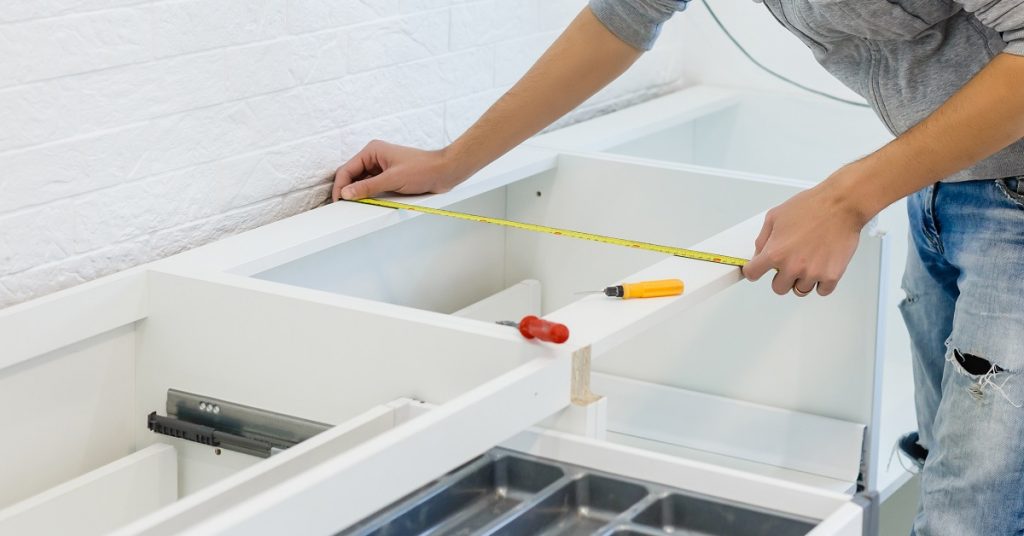Chip Wade Answers the Age Old Question of Floor or Cabinets First
Should you install kitchen cabinets or floors first? It’s a question that lingers in every kitchen renovation. Every contractor has their own preference. If you’re managing your own remodel (or DIYing the remodel) you need real answers.
That’s where expert Chip Wade comes in. As a master craftsman and regular on home improvement television shows, he’s tuned into the needs of the DIYer. We talked with Chip recently to find out what goes first, cabinets or flooring.
“Renovation goes a lot faster if you do it in the right order of operations,” Chip began. “Cabinets are the meat and potatoes, the sun in the solar system that everything else revolves around so it’s important to get them in at the right time.”
Does flooring go under kitchen cabinets? Yes, that’s Chip’s recommendation unless you have a floating floor or a thicker floor. Here’s the details.

Floors First for Longevity
Chip puts down the floor first 90% of the time. “It’s a more straightforward start. It gives you a clean playing field. It’s safer to floor under everything,” he told us.
Starting off right goes a long way to make a kitchen remodel successful.
Besides having a clean start, another big reason to put down floors first is longevity. Think of the future. You’ll run into more remodeling issues down the road if you put in the cabinets first.
What if you need to change out appliances or you decide to do additional remodeling down the road? Putting down the floor before the cabinets makes for clearer sailing now and into the future.
Treat the floors under your cabinets like a permanent installation. They should receive the same treatment as the rest of your floor. Just because they won’t show doesn’t mean you can cut corners. The integrity of the floor now and any future plans will be best served by a 100% complete floor.
Cabinets First for Particular Types of Flooring
Chip prefers to put down flooring before cabinets in most cases. But there are two instances when that all changes: floating floors and thicker floors.
Floating Floors
Can you put cabinets on a floating floor? No, cabinets should be installed first. Floating floors need space to expand and contract.
A floating floor is a plank floor with tongue and groove installation. It comes in many different types like engineered hardwood, laminate, vinyl, etc.
They are not secured directly to the subfloor. They “float” on top of it. They expand, contract, and move with the house. However, if you put cabinets on top of them, they can’t shift and there may be problems down the road.
Thick Floors
Thicker flooring materials (greater than 1/2″) won’t impact your cabinet installation, but they can spell trouble for your appliances. Even if you put in appliances before thicker flooring, you’re it’s very hard to get them out when it’s time to replace them. Be sure to use a flooring that is less than 1/2” to avoid problems retrofitting appliances.
Quick Guide
| Hardwood & Tile | Install flooring first to prevent height misalignment. |
| Laminate & Floating Floors | Install cabinets first to allow flooring to expand and contract naturally. |
| Vinyl & Luxury Vinyl Plank (LVP) | Can be installed either way, do floors first for a quality job, but many prefer cabinets first to reduce material costs. |
Do you put kitchen cabinets on top of flooring? For most solid flooring types, yes. For floating floors, no.

But What About Potential Damage if You Install Floors First?
One of the big arguments in the cabinets-first camp is the possibility of damage to floors as construction continues. Chip recommends three remedies.
- Work from top to bottom (paint the ceiling before the cabinets or flooring go in) so overhead work doesn’t threaten what’s below.
- Save finishes until the end. That way you won’t have to do it twice if something goes amiss in the meantime.
- Protect, protect, protect! Cover the floors until work is complete. Put down cardboard when it’s time for appliances to come in.
Now that you’ve considered all the issues, take a closer look at your options.
Option 1: Installing Flooring First
Pros
- Provides a seamless look with flooring running continuously under cabinets.
- Easier future replacements if you change your cabinets.
- Avoids issues with dishwasher height and toe kicks.
Cons
- More expensive as you’ll be paying for flooring that remains hidden under cabinets.
- Potential risk of damage to flooring during cabinet installation.
Best For: Hardwood, tile, and vinyl flooring.
Option 2: Installing Cabinets First
Pros
- Saves money by only installing flooring where it’s visible.
- Prevents the risk of damaging flooring when installing heavy cabinets.
- Allows for more flexibility in cabinet height and leveling.
Cons
- Can make future flooring replacement more difficult.
- May require extra trim work or fillers for a finished look.
Best For: Floating floors (laminate, engineered wood), budget-conscious remodels.
What goes first, flooring or cabinets? For Chip Wade, usually the floor. Whatever your particular specs and needs, follow his advice for a successful cabinet installation every time.
Need more on doing your remodel in the right order? Read on.
About Chip Wade
As an Emmy-winning television host and producer, Georgia Tech engineer, HGTV designer, and third generation craftsman, Chip Wade’s career is dedicated to helping people and businesses make educated and inspired decisions in the home and lifestyle category. Chip is the owner and lead designer of Wade Works Creative, offering services in video and digital productions, residential and commercial design, architecture, and building one-of-a-kind amazing stuff.










